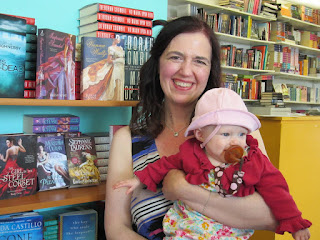Plots & Devices
 My daughter Mélanie and I just got back from a lovely few days in New York, including fun visits with my editor and agent. There we are to the left at the Nancy Yost Literary offices. As often happens, I'm in multiple stages on multiple projects. I’m revising The Paris Affair which will be out in April 2013, I just got copy edits for His Spanish Bride, the novella about Malcolm and Suzanne’s wedding which will be out in e-format in late November, and I’m starting to plot the next Malcolm and Suzanne book, which is one of my favorite parts of the writing process.
My daughter Mélanie and I just got back from a lovely few days in New York, including fun visits with my editor and agent. There we are to the left at the Nancy Yost Literary offices. As often happens, I'm in multiple stages on multiple projects. I’m revising The Paris Affair which will be out in April 2013, I just got copy edits for His Spanish Bride, the novella about Malcolm and Suzanne’s wedding which will be out in e-format in late November, and I’m starting to plot the next Malcolm and Suzanne book, which is one of my favorite parts of the writing process.And of course, inevitably plotting involves research. I usually interweave the research and plotting. Often the plot idea comes from research. But then I need to start thinking about the plot to figure out what direction my research needs to take. And as I do more research, that further drive the plot. Even though I've written in the Regency/Napoleonic era for over twenty years (hard for me to believe!) it seems as though there’s always more to learn. A different setting, a different aspect of society, a different set of real historical characters. That's what keeps it both challenging and interesting.
With Vienna Waltz, the idea for the book grew directly out of research. I'd been fascinated with the Congress of Vienna for years, and the the premise for the book came specifically from my research into two real life women, Wilhelmine of Sagan and Princess Catherine Bagration, who were both involved with both Prince Metternich and Tsar Alexander during the Congress. What if (two of my favorite words in the plotting process) there was a third, fictional woman who was involved with both men? What if she was murdered after summoning both of them? What if my hero, Malcolm, found her. No, what if my heroine, Suzanne, his wife, found her husband kneeling over the murdered woman...
The idea for Imperial Scandal came to me as I was driving home along a pretty stretch of country road after taking my cats to the vet. I already knew the book would involve the battle of Waterloo, but that was when I got the idea of Malcolm summoned to a mysterious meeting at a château outside Brussels, an ambush, a British officer's wife who shouldn't have been anywhere near the château killed in the crossfire. Then it was a game of "what if" to figure out what the woman was doing there, who she was, why she was killed.
With The Paris Affair, I knew I wanted the murder victim to be threatened by the post-Waterloo White Terror reprisals against Bonapartists. I wanted him to appeal to the British for help, which would pull Malcolm and Suzanne in. And I knew I had to add in something to make the stakes personal for Malcolm and Suzanne.
My idea for the book I'm starting to plot came while driving with Mélanie to a one-year-old's birthday party and thinking about Shakespeare. It's still too unformed to say much more but I'm excited about it.
Then, in the midst of writing Imperial Scandal, I discovered the writing software program Scrivener. I love Scrivener for numerous reasons, but one is that it has a corkboard built in. You can lay out scenes on index cards, switch to a writing view to draft a scene, then switch back to the corkboard. Because of this, with The Paris Affair, which is the first book I wrote completely in Scrivener, I found I could write as I was plotting. If knew a scene had to occur later in the narrative, I could jump ahead and write it while I was still working out plot details earlier in the story. I spend a lot of time mulling when I’m working out a plot, and this way I was able to write while I was mulling. I was a little nervous about writing out of order, but I found it was surprisingly easy to pull the scenes together with transitions and other scenes that needed to be filled in. And being able to switch to the corkboard view at any point (as well as an outline view) makes me feel much more in control of the plot than I did with loose index cards. All of which made me more efficient, which was particularly helpful for this book as I had a baby in the midst of writing it.
Writers, what’s your plotting process? What tools have you found that help with it? Readers, do you find it interesting to read about the writing process behind the book? What questions do you have?



Comments
Post a Comment